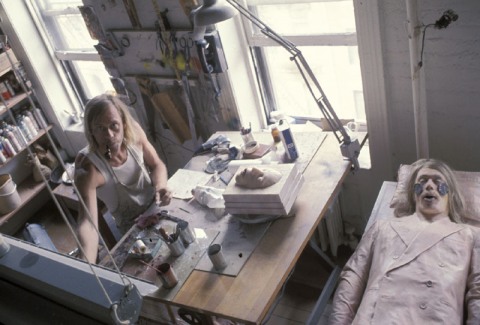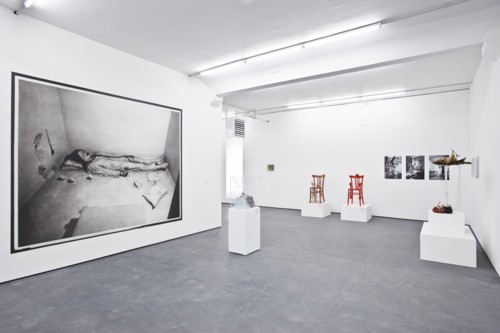[Earlier this year I saw a great show by Paul Thek, a deceased New York artist who worked most spectacularly in Europe. The show will never come here, of course, since they loved him there. I wrote it up, and an editor sat on it until it was dead. I’ve been urged to post the notice here, so here you go. The catalogue is due out or is out from MIT Press.]

Madrid’s Reina Sophia is the last leg of a touring retrospective of Paul Thek. Notorious for his 1968 “Dead Hippie” sculpture, Thek, a New Yorker who died in 1988, is underknown. This show is tremendous, revelatory. Much of what has happened in the last 20 years he may be said to have anticipated. (While I cannot easily read the catalogues in Spanish and German – it’s coming out in English in May, I gather from the illustrations that the authors are saying that.) Most of this work is in European collections, so this most singular and syncretic of American artists may not soon be well seen in the United States.
I know the arc of Thek´s work only from catalogues. (He was a favorite of über-Kurator Harald Szeeman, who jammed Thek like Beuys into his categorical imperative of “personal mythologies.”) I’ve also seen his work in a few shows in NYC. Thek spent the last decades of his life holed up there painting, and that is what you see in gallery shows. But the guy really whaled in Europe, working collaboratively to build spectacular installations at the turn of the ‘60s into the ‘70s. So, while I´ve seen Thek in NYC, I had no idea what he was about.

This survey show begins with a group of photographs taken by Peter Hujar, also recently shown in NYC as a mentor to David Wojnarowicz. Thek was along with Hujar during the famous excursion to the Palermo catacombs in 1963. Thek´s “Tomb,” then (aka “Dead Hippie”), as well as his fixing on the wax form emulation of human remains is tracked out of this formative moment, a conjunction, we may assume, of death in display, bodily representation and sex.

For “Tomb,” Thek made a wax dummy of himself lying in psychedelic state and displayed it at the Whitney Museum. (Neil Jenney helped him.) Colloquially called “Dead Hippie,” Thek´s “Tomb” was included as part of a massive 1972 Documenta installation. In the catalogue, Peter Weibel connects the work to the Diggers´1967 funeral for Hippie in San Francisco (he illustrates the “Death of Hip” cover of the underground newspaper the Berkeley Barb).

The “technological reliquaries” series, in which bloodied meat chunks are displayed/contained within luminescent radioactive-appearing plastic and metal boxes, anticipates today’s hyper-horror and mutilation movies. Those are often said to be a return of the repressed for escalating horrors of modern war (e,g. Israeli army´s recent use of phosphorus and small particle bombs against the densely crowded cities of Gaza) – sanitary mass murder. It’s a fair bet Thek intended that connection.
But as art objects these are perfect fusions for their moment of minimality and humanism, a melding of a Judd-like purity (as well as anticipating his eccentriticities as a “colorist”) and Eva Hesse´s “eccentric abstraction.” But in his use of Madame Tussaud-like (or Palermoesque) chunks of flesh, Thek amps the whole thing up – or down, down, down to Coney Island. (The great eccentric wax museum there closed in the early 1980s, despite artists’ efforts to save it.)
In his content and intention, Thek is a thoroughgoing humanist. In fact, he´s a Christian. Not orthodox it seems, despite his frequent allusions to Catholic usages. But a syncretist – fascinated with the cosmic, and grand religious narratives of many stripes. This is stuff the keepers of American art have never really cared for. It’s embarrassingly non-secular, really unmodernist..

But it seems his Christianic mysticism did not close things down for Thek, as it may be argued it did for French Symbolists and Cubists of the last century. Rather his mysticism opened up ranges of content and subject matter, as in his “Uncle Tom´s Cabin with the Tower of Babel” (1976), a weird bronze in which red-painted rats construct and scamper up a rickety construction arising from a carefully rendered shanty. Weird, incomprehensible, a radical juxtaposition of symbolic structures, but instantly appealing like a children´s toy.
Thek’s work seems to respond continuously to other global artists in unique and stimulating ways. During an era when New Yorkers were striving to forge a “signature style” in the hothouse of their artworld – which was seen as absolutely a market imperative during the hot ´60s – Thek was a mixmaster.



In a series of weird chair things he made for “A Procession in Honor of Artistic Progress” (1968), I descry a straight reaction to artists like Lygia Clark and Helio Oiticica. It seems like a funny response, like Santiago Sierra´s “Los Penetrados” show (also up in Madrid) of pictures of fucking couples in situations he arranged parodies the naked-into-this-world communities of Spencer Tunick (around which policemen have sold surveillance camera photos), and responds to Vanessa Beecroft´s parades of models as nudes. Sierra is raw, of course; for him it’s about the money. He seems to say art makes sex work work.
What kind of rejoinder is Thek’s chair with shoulder pads top and bottom to the interactivist researches of artists like Clark and Oiticica? Well, it´s certainly a device for potential sensuous human contact!, of queer kinds we may well imagine. A photo shows the artist looking cool in his sunglasses with the top of his head poking out of a chair seat.

Thek drew and painted constantly. (This is the only stuff you see in the NYC galleries.) In the context of the rest of his work it makes sense. The curators have mined his sketchbooks, the parade of closely rendered drawings of his friends in idyllic settings, in boats along coastlines. His paintings on newspaper occupy many galleries. (These might have been given over, as in the ZKM installation, to evocations of the great collaborative works, but the Reina Sofia people decided not.) I liked that they were first grounded on the fragile degenerating newspaper by a field of paint – it’s a sculptor painting. A binder holds the paint on top of it, not the support. It’s also cheap, and like the Cubist paper collage, lets contemporary content leak through at every moment.
Cordoned off from us by another work, wires hung with scraps of “meat,” was the only piece in the show by the Artist´s Co-op (from the Kunstmuseum in Lucerne). This was the group with whom Thek worked continuously to make spectacular and greatly messy installations in the late ´60s and early ´70s. “Dwarf Parade Table” (from the Stedelijk Museum) is in form a long table, raised, cut through, papered with photos, and hung beneath with star-like napkins and paint smeared taxidermy. It is supported at one end by a group of small chairs, and at the other by an outsized garden dwarf sculpture. (This talisman of Paul McCarthy is undoubtedly a direct homage to Thek.)

Thek also made paintings with this group. A series of triangular paintings, gouaches of seas and skies, are trimmed with inscribed prayers. These works, and others, like the meticulous drawings of calligraphed animals, snakes, rabbits, sheeps, stags, called “Drawings for Ark, Pyramid-Easter,” the giant crazy installation for Documenta 5 in ´72, are ascribed to Thek, Ann Wilson and Artist´s Co-op.
Some of this gang – Wilson? – appear in a videotape produced by Witte de With in 1995, playing at the end of the show by the table of catalogues (on inch-long chains, inducing a peculiar reader´s yoga). In this video, Wilson is one spacey lady. Thek explains to some apparently baffled interviewer that he was “sick and tired of working only by myself.” Finally, he is seen dancing to the Jerry Jeff Walker song “Mr. Bojangles.” Ugh, man. Hippie shit is one thing, but nostalgic emotionally manipulative recollections of hippie shit is something else. At least this weird video was thrown to the end of the show.

It´s really an open question how to make a retrospective like this with a 10 years dead complex underknown contemporary artist. For the most part, this show is brilliant. They didn´t cop too hard to object bias. And the paintings became really important for Thek late in his shortish life, as the pretty little room of “Small Paintings” proves, hung and spotlit around a dark plush room with little chairs to sit and see them by.


Except you can´t any longer sit in them. Nor on the massive sturdy bench set up to contemplate the garden of “Visual Therapy dedicated to Archbishop Raymond Hunthausen” (1986), a cleric who publicly opposed nuclear proliferation, to the point of urging non-payment of taxes as a solution.
In fact, Thek´s Christianity, his choices of what to affirm in his work, do a lot to reconstruct the religion at a moment when its smarmy alliance with power has reduced its credibility.
The show has been last year at Sammlung Falckenberg, Hamburg, ZKM in Karlsrühe, and is concluding at Reina Sofia, Museo Nacional Centro de Arte.
Photo:
Paul Thek with the Artist's Co-op, “Pyramid/A Work in Progress,” 1971-72, Moderna Museet, Stockholm, 1971, Installation in Cooperation with Michèle Collison, Toby Schümmer, Franz Deckwitz, Edwin Klein and Ann Wilson, photo: Erik Cornelius/Statens Kunstmuseer, Stockholm
| Attachment | Size |
|---|---|
| easterwelcome.jpg | 30.9 KB |
More on Paul Thek.
Great text Alan. I mentioned your review of this important retrospective to Christiane Paul, adjunct curator at the Whitney. Also that the show had traveled to various European venues but was not scheduled for an American museum. She indicated a Thek exhibition is being planned at the Whitney, I think for 2011. I do not know what relation it bears to the show you reviewed above, but will post details as they arrive.
In the mid 1980s, when I was curating in NYC, I was introduced to Thek and placed him in my Stigmata show on Bond Street. Also included was work by Kiki Smith, Alan Vega, Michael Byron, and a relic from a Hermann Nitsch performance belonging to Wolfgang Staehle.
Thek contributed one of his signature meat pieces to the exhibition, a green tinted Plexiglass box, some panels marked with a grid, containing a waxen effigy of layered muscle, dermis and skin, a lasagna-like square of "flesh". Here is a similar piece.
I met Thek towards the end of his life. He knew he had AIDS, and while the illness necessarily slowed him down, he remained droll and subversively intelligent, with an intuitive, mystical bent, impatient of any semblance of conventional wisdom. During our brief acquaintance, I found him modest, uncompromising and - at the risk of citing that chestnut - visionary. In his case it actually applies.
Gary Indiana penned an elegant remembrance of Thek earlier this year. Well worth reading.